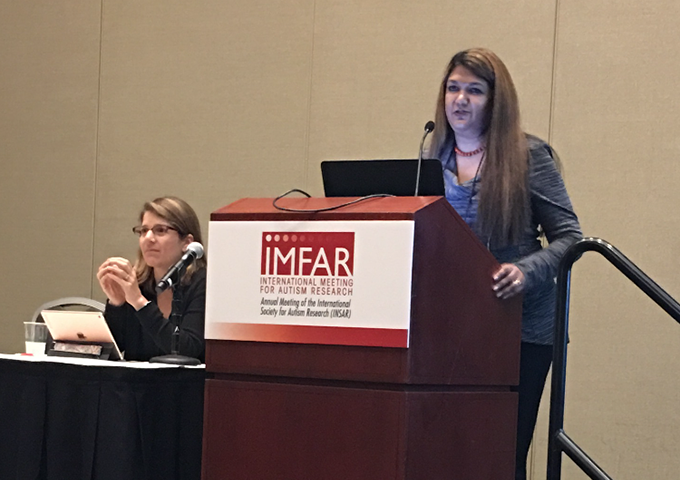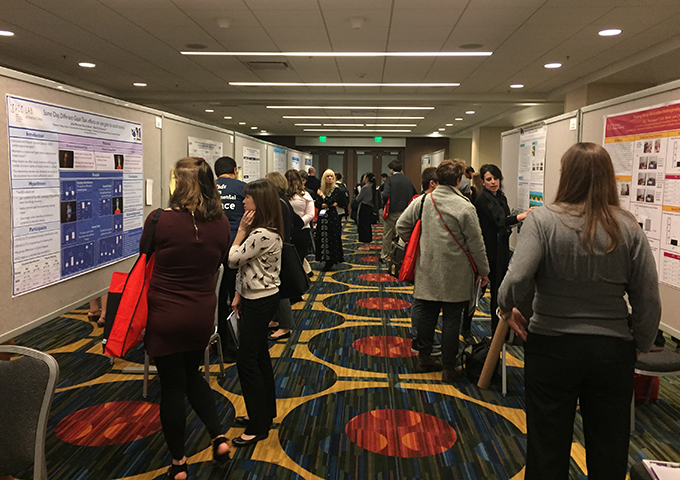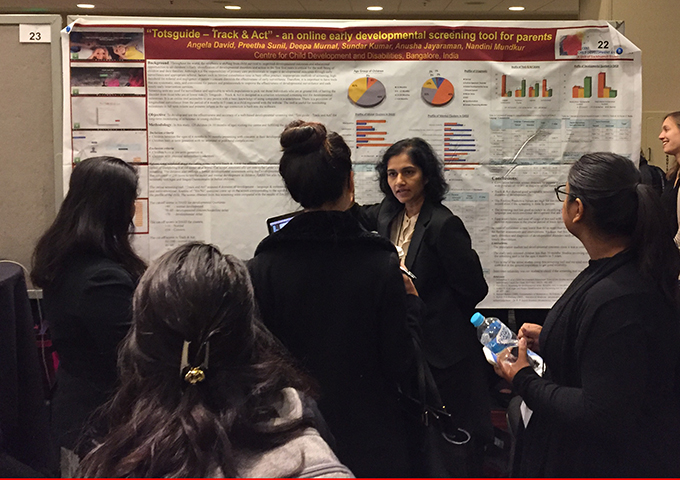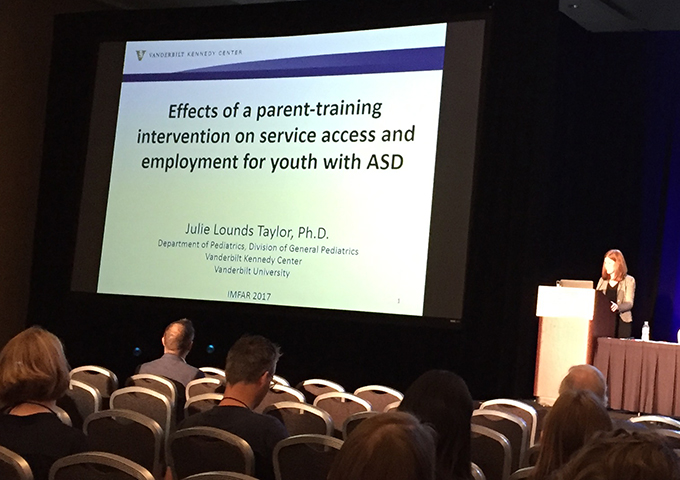
IMFAR 2017: The International Meeting for Autism Research

Keynote Address and INSAR Awards Ceremony, Lifetime Achievement Awardee

Interventions to Improve Transition Outcomes By Strengthening Environmental Supports
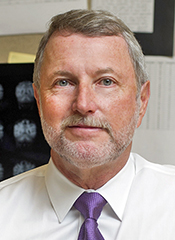

Altered Sensory Processing and Social Functioning in ASD: Examining Associations and Mechanisms through Multiple Methods and Populations

- Slide Presentation (PDF 2 MB)
- Abstract
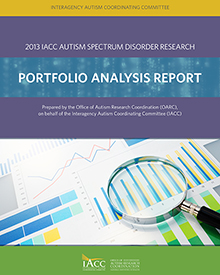
ASD Research Portfolio Analysis Report
- The Portfolio Analysis Report provides a comprehensive analysis of the ASD research portfolios of major U.S. Federal agencies and private organizations
- Includes alignment analysis of funded research with IACC Strategic Plan question areas and objectives, multi-year funding trends, funder information, and more
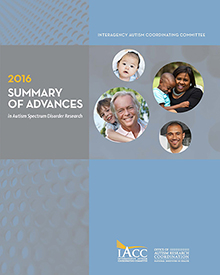
IACC Summary of Advances in ASD Research
- Includes short, plain language summaries of annual top 20 research articles selected by the IACC to highlight research advances from the previous year
- Research articles are grouped according to the seven Strategic Plan question topics
| Topic | Topic Description |
|---|---|
| Dates: | May 10-13 |
| Agenda: | The International Meeting for Autism Research (IMFAR) is an annual scientific meeting, convened each spring, to exchange and disseminate new scientific progress among ASD scientists and their trainees from around the world. The aims of the meeting are:
|
| Place: |
Marriott Marquis Hotel 780 Mission Street San Francisco, California 94103 USA |
| Program Book: | Online Program |
| INSAR | About INSAR |
Back to Top
J. L. Taylor, R. M. Hodapp, M. M. Burke, S. N. Waitz-Kudla and C. Rabideau, Vanderbilt University Medical Center, Nashville, TN, Vanderbilt Kennedy Center, Nashville, TN, University of Illinois at Champaign-Urbana, Champaign, IL
Background: When youth with autism spectrum disorder (ASD) leave high school, they encounter an adult service system that is underfunded and difficult to navigate; this serves as a significant barrier to accessing appropriate services and support. In response, our group developed the Volunteer Advocacy Program-Transition (VAPT), which equips parents to more effectively navigate the adult service system on behalf of their son/daughter with ASD. In initial findings from a small randomized controlled trial (RCT), we found that relative to control group parents, those who participated in the VAP-T knew more about adult services, and felt more empowered and skilled in advocating. It is unclear, however, whether increased parental knowledge/empowerment leads to improved transition outcomes for youth.
Objectives: To test whether parent participation in the VAP-T led to increased service access and higher rates of community employment/post-secondary education (PSE) for transition-aged youth with ASD
Methods: We examined the efficacy of the VAP-T using an RCT, waiting-list control design with families of youth with ASD who were within 2 years of high school exit. After completing pre-test measures, families were randomly assigned to the intervention group or a wait-list control. Parents in the intervention group met weekly for 12 weeks; each session lasted 2.5 hours. Sessions covered aspects of the adult service system (e.g., Vocational Rehabilitation, post-secondary education programs, SSI, SSDI) and advocacy skills. All youth had ASD diagnoses confirmed using the Autism Diagnostic Observation Schedule-2 administered by research-reliable clinicians. 38 families (19 treatment, 19 control) have completed the 6-month follow-up thus far. At this time, 55% of youth were in high school and 45% had exited. The sample of youth was 18% female, and 32% had an intellectual disability. Outcomes, measured six months after the intervention group completed the VAP-T, included the number of services youth were receiving and whether youth were currently working in the community or in a PSE program.
Results: Youth with ASD whose parents were in the treatment group were more than twice as likely as the control group to be working in the community or in PSE (47% vs. 21%), Fisher’s Exact Test p-value = .09. Group effects were more pronounced for those out of school; 86% of treatment group youth who had exited high school were working in the community or in PSE, compared to 30% of control group youth, Fisher’s Exact Test p-value = .04. Relative to the control group, treatment group participants may be receiving more services (3.60 vs. 3.00), although the difference was not statistically significant. Further analyses will examine whether intervention effects on service access depend on high school exit (in/out of high school) or whether the youth has an intellectual disability.
Conclusions: A Training parents how to navigate the adult service system may lead to higher rates of employment/PSE participation for youth with ASD, and perhaps to better service access. Discussion will highlight the importance of intervening at the level of the family, when working to strengthen environmental supports for youth with ASD during the transition to adulthood
Panel Chair: Mirella Dapretto, University of California, Los Angeles, Los Angeles, CA
Discussant: Kevin Pelphrey Yale University, New Haven, CT
Individuals with ASD have extremely high rates of sensory processing atypicalities, including over-responsivity, under-responsivity, and sensory seeking (Ben-Sasson et al., 2008). However, sensory symptoms have been understudied until recently, when they were added to the DSM-5 diagnostic criteria for ASD. Since then, sensory processing abnormalities have been increasingly recognized to be associated with greater impairment, including more social deficits (Glod et al., 2015). However, there has been little research examining how and why sensory processing difficulties are associated with social impairment. This panel addresses possible mechanisms underlying the association between atypical sensory processing and social symptomatology while highlighting recent advances in behavioral, physiological, and imaging methods for studying sensory processing from infancy throughadolescence. Teresa Tavassoli will present data examining whether sensory and social symptoms are differentially associated across children with ASD, Sensory Processing Disorder, and typical development. Blythe Corbett will discuss the association between sensory symptoms, social difficulties, and accumulated stress (as indexed by evening cortisol). Shulamite Green will address neurobiological mechanisms underlying the effect of distracting sensory stimuli on social cognition. Finally, Carissa Cascio will present on sensory seeking and frontal alpha asymmetry as longitudinal predictors of social functioning in infants at high and low risk for ASD.
Exploring the Relationship Between Sensory and Social Symptoms of Autism
T. Tavassoli, L. J. Miller, S. A. Schoen, J. Brout, J. C. Sullivan and S. Baron-Cohen, Seaver Autism Center, New York, NY, STAR Institute for SPD, Greenwood Village, CO, Sensory Processing Disorder Foundation, Greenwood, CO, Duke University Medical Center, Durham, NC, Northeastern University, Boston, MA, (6)Autism Research Centre, Department of Psychiatry, University of Cambridge, Cambridge, United Kingdom
Background: Children with autism spectrum conditions (ASC) often show atypical sensory reactivity symptoms in addition to social difficulties compared to typically developing (TD) children. It is unknown, however, whether sensory and social symptoms in ASC might be related to one another. To test this relationship we compared children with ASC to children who exhibit similar sensory symptomatology but do not have ASC, that is, children with the suggested diagnostic term ‘sensory processing disorder’ (SPD).
Objectives: A The goals of this study were to determine if a) sensory and social symptoms are related, and b) if children with ASC could be distinguished from children with SPD based on sensory and/or social features. Specifically, we sought to differentiate children with ASC and SPD on sensory subtypes (e.g. over-reactive, underreactive and sensory craving) and amount of sensory symptoms and/or on social features, specifically empathy using parent questionnaires.
Methods: The study included 210 participants: 68 children with ASC, 79 children with SPD and 63 typically developing (TD) children. We used the Sensory Processing Scale Inventory to measure sensory symptoms (over-reactivity, under-reactivity and sensory craving); the Autism Spectrum Quotient (AQ) to measure autistic traits, and the Empathy Quotient (EQ) to measure social skills.
Results: Children with ASC and SPD showed more sensory symptomatology than TD children (p< .01). Furthermore, even though children with SPD had higher empathy scores compared to children with ASC, they had lower empathy scores compared to TD children (p< .01). Last, sensory symptomatology and social features showed a negative correlation with each other, across groups.
Conclusions: Taken together, our findings suggest that there is a relationship between sensory symptomatology and social aspects of ASC. Children with ASC are most affected by sensory symptoms, and show lowest empathy. Children with SPD lie in between children with ASC and typical developing children on these measures. Future longitudinal studies are needed to explore if children with ASC and SPD both start with the same amount or type of sensory symptoms in early childhood and whether there is a difference in the type of sensory symptoms they display. This study also sheds light on the similarities and differences between children with ASC and SPD. Improved sensory and social phenotyping is an essential first step towards reducing diagnostic confusion between ASC and SPD.
Examining Tactile Sensitivity and Associations with Physiological Arousal and Social Functioning in Youth with Autism Spectrum Disorder.
B. A. Corbett, and R. A. Muscatello, Psychiatry and Behavioral Sciences, Vanderbilt University Medical Center, Nashville, TN, Neuroscience Graduate Program, Vanderbilt University, Nashville, TN
Background: Autism spectrum disorder (ASD) is characterized by significant difficulties in social cognition and communication, as well as impairments in sensory processing. Previous findings have consistently shown elevated evening cortisol in youth with ASD compared to typically developing (TD) peers (Tomarken et al., 2015), suggesting increased accumulation of stress throughout the day (Corbett et al., 2009). Various factors may underlie this increased arousal, to include significant stress from social interaction, changes throughout the days, or heightened sensory sensitivity to internal or external stimuli.
Objectives: The current study examined potential associations between sensory processing, physiological arousal, and social responsiveness in ASD. It was hypothesized that underlying sensory defensiveness would be associated with increased arousal and reduced social functioning in youth ASD.
Methods: A large sample (N=113) of youth with ASD (N=64) or TD (N=49) between 8 and 17 years of age were recruited. Evening cortisol was collected as part of a larger study, which collected diurnal salivary samples over 3 days at home, 4 times per day (Immediate Waking, 30-min post-waking, afternoon, and evening). Sensory sensitivity was reported using the Short Sensory Profile (SSP). Social functioning was assessed by three parent-report measures including the Social Communication Questionnaire (SCQ), Social Responsiveness Scale (SRS), and the Child Behavior Checklist (CBCL). Pearson product correlations were conducted to measure levels of association between dependent variables
Results: Sensory functioning (SSP) was negatively correlated with evening cortisol at trend-level (r=-.18, p=0.08). When individual subscales of the SSP were explored, a significant negative correlation was observed for the Tactile domain and evening cortisol (r=-.28, p=0.007). Moreover, the SSP Tactile domain was also negatively associated with measures of social functioning, including the SCQ (r=-.64, p<0.001), the SRS total score (r=-.69, p<0.001), and the social problems subscale on the CBCL (r=-.69, p<0.001). Within group comparison for the ASD group, corroborated relationships between tactile sensitivity and physiological and social functioning: SSP Tactile showed negative associations with evening cortisol (r=-.31, p=0.03), SCQ (r=-.33, p=0.02), SRS (r=-.43, p<0.001), and social problems on the CBCL (r=-.61, p<0.001). In the TD group, tactile sensitivity was only correlated with total SRS (r=-.36, p=0.01)
Conclusions: The study reveals significant associations between evening cortisol, sensory processing, and social functioning. Tactile sensitivity was related to physiological regulation and social responsiveness, such that impaired tactile processing corresponded with elevated evening cortisol and greater impairment in social functioning. Findings suggest sensory processing, especially tactile defensiveness, may underlie a number of symptoms in ASD, including accumulated stress, social responsiveness, and social symptom severity. The lack of significant findings in the TD group further suggest this underlying role of sensory processing may be unique to ASD. Tactile responsiveness may serve as a marker of more significant impairment in other core symptom domains, and future research should be directed towards understanding the directionality of these relationships, such that treating one symptom may directly or indirectly improve the others.
Sensory over-Responsivity and Social Cognition in ASD: Effects of Aversive Sensory Stimuli and Attentional Modulation on Neural Responses to Social Cues
S. A. Green, L. M. Hernandez, H. Bowman, S. Y. Bookheimer and M. Dapretto, Ahmanson-Lovelace Brain Mapping Center, UCLA, Los Angeles, CA, University of California Los Angeles, Los Angeles, CA, NPI Psychiatry, UCLA, Los Angeles, CA, University of California, Los Angeles, Los Angeles, CA
Background: Sensory over-responsivity (SOR) is an impairing condition manifested as extreme sensitivity to stimuli such as unexpected loud noises or being touched. SOR is particularly common (rates of 56-70%) in autism spectrum disorders (ASD) and, notably, it is associated with higher impairment including greater deficits in social and adaptive behavior (Ben-Sasson et al., 2008). Although SOR is strongly linked to impairment, the mechanisms through which it disrupts social functioning are not well understood. Previous research from our lab suggests that SOR may be related to an overattribution of salience to extraneous sensory information. Individuals with ASD and SOR show hyperactivation and reduced habituation in the amygdala and sensory cortices in response to mildly aversive sensory stimuli (Green et al., 2015), as well as increased salience network connectivity with amygdala and somatosensory cortex (Green et al., 2016). Taken together, these studies suggest that SOR is associated with atypical allocation of attention to extraneous sensory stimuli rather than relevant social stimuli. Yet, the effect of sensory distracters on the brain’s ability to process social information has not been tested directly.
Objectives: To examine the effect of a tactile sensory distracter on brain responses during a social cognition task, and to test whether explicitly directing attention to relevant social cues can mitigate the effect of the sensory distracter.
Methods: Participants were 15 children and adolescents with ASD and 16 TD matched controls, between 8-17 years of age. While undergoing fMRI, children completed a social cognition task, which involved determining whether a speaker was sarcastic or sincere. They completed the task with/without a tactile sensory distracter, and with/without instructions directing their attention to relevant social cues. Parents completed the tactile scales of the Short Sensory Profile (Dunn, 1999) and SenSOR Inventory (Schoen et al., 2008); scores were combined into a tactile SOR composite.
Results: When completing the task in the presence of the sensory distracter, TD youth showed increased activity in auditory language and frontal regions whereas ASD youth showed decreased activation in these areas. Instructions mitigated this effect such that ASD youth no longer showed decreased activation during tactile stimulation; instead, the ASD group showed increased medial prefrontal (mPFC) activity. With attentional instructions, higher SOR was associated with greater activity in primary auditory and visual cortex as well as higher-level language and face processing regions, whereas lower SOR was associated with greater activity in temporal pole and mPFC, regions associated with integrative social cognition such as inference and theory of mind.
Conclusions: Results demonstrate for the first time a neural mechanism through which sensory stimuli may disrupt social cognition, and that attentional modulation can restore neural processing of social cues through prefrontal regulation. Attentional modulation may work through different mechanisms depending on level of SOR: youth with high SOR may rely on processing individual visual and auditory stimuli whereas youth with low SOR may be better able to integrate and interpret multiple social cues. Findings have implications for novel, integrative interventions that incorporate attentional directives to target both sensory and social symptoms.
Neurophysiological Substrates and Developmental Sequelae of Sensory Seeking in Infants at High Risk for Autism Spectrum Disorder
T. Woynaroski1, C. Damiano, D. M. Simon, L. V. Ibanez, C. R. Newsom, M. Murias, M. T. Wallace, W. L. Stone and C. J. Cascio, Hearing and Speech Sciences, Vanderbilt University Medical Center, Thompsons Stn, TN, University of North Carolina, Durham, NC, Program in Neuroscience, Vanderbilt University, Nashville, TN, UW READi Lab, Seattle, WA, Pediatrics, Vandetbilt University Medical Center, Nashville, TN, Duke University, Durham, NC, Vanderbilt University, Nashville, TN, Psychology, University of Washington, Seattle, WA, Vanderbilt University School of Medicine, Nashville, TN
Background: Children with autism spectrum disorder (ASD) show a broad range of unusual responses to sensory stimuli and experiences. It has been proposed that early differences in sensory responsiveness may arise from atypical neural function and produce “cascading effects” on development across a number of domains. A primary challenge to confirming these hypotheses is that ASD cannot always be definitely diagnosed in the earliest stages of development (i.e., infancy). A potential solution is to prospectively follow infants at heightened risk for ASD based on their status as infant siblings of children who are diagnosed. The present study examined the developmental sequelae and possible neurophysiological substrates of a specific sensory response pattern: unusually intense interest in nonsocial sensory stimuli or “sensory seeking.” Infants at high risk (HR) for ASD were compared to a control group of infants at relatively lower risk for ASD (LR; siblings of children with typical developmental histories).
Objectives: Research questions included: a) Do HR infants differ from LR infants in sensory seeking behavior?, b) Does sensory seeking predict concurrent social orienting and future socialization?, and c) Is sensory seeking predicted by early frontal alpha asymmetry?
Methods: To answer these research questions, we carried out a longitudinal correlational investigation in which 20 HR infants and 20 LR controls were followed over 18 months. At entry to the study, sensory seeking and social orienting were measured in 18-month-old infants using the Sensory Processing Assessment, and alpha asymmetry was measured via resting state EEG. Eighteen months later, social symptomatology was evaluated in a comprehensive diagnostic evaluation.
Results: HR infants showed elevated sensory seeking relative to LR controls (t(38)=2.26, p = .029), and increased sensory seeking predicted reduced social orienting across groups, concurrently (β=.570, t=2.822, p < .0001) at eighteen months. Seeking behavior additionally predicted future social symptomatology across groups (β=.376, t = 2.78, p = .008), but this effect varied by group (seeking*risk group interaction β=.672, t=4.448, p =.008), such that higher seeking at 18 months predicted increased social symptoms in the HR group, but decreased social symptoms in the LR group. A mediation analysis indicated that social orienting mediates the relation between sensory seeking and social deficits, and that this effect is moderated by risk group. The relation between frontal asymmetry and sensory seeking at 18 months also varied according to risk group (seeking*risk group interaction β=-2.458, t=-3.38, p = .002), such that increased sensory seeking was associated with greater right asymmetry in the HR group, but with greater left asymmetry in the LR group.
Conclusions: Findings suggest that sensory seeking may produce cascading effects on social development in infants at heightened risk for ASD by impeding social orienting early in life. Atypical frontal alpha asymmetry may underlie this atypical behavioral pattern of sensory responsiveness.
S. Daniels, Office of Autism Research Coordination, Rockville, MD
Background: In this talk, the Office of Autism Research Coordination (OARC), which coordinates and manages the Interagency Autism Coordinating Committee (IACC), will provide an update on the IACC and its recent activities. The Interagency Autism Coordinating Committee (IACC) is a federal advisory committee established by Congress to coordinate activities concerning autism spectrum disorder (ASD) within the U.S. Department of Health and Human Services (HHS) and among member federal agencies. The committee, composed of 31 federal officials and public stakeholders representing diverse perspectives, provides advice to the Secretary of HHS on issues related to ASD.
Objectives: The talk will cover background information about the committee and a description of the latest updates to the IACC Strategic Plan, which serves as a guide to federal funders of ASD research and services activities. An update on U.S. federal funding of autism research and recent ASD-related initiatives from the NIH will also be discussed.
Methods: NA
Results: NA
Conclusions: NA








